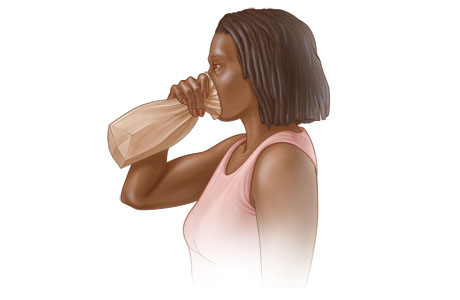Our Health Library information does not replace the advice of a doctor. Please be advised that this information is made available to assist our patients to learn more about their health. Our providers may not see and/or treat all topics found herein.
Using a Paper Bag to Control Hyperventilation

Try these steps to control hyperventilation
- Take 6 to 12 easy, natural breaths, with a small paper bag held over your mouth and nose. Then remove the bag from your nose and mouth and take easy, natural breaths.
- Next, try belly-breathing (diaphragmatic breathing).
- Alternate these techniques until your hyperventilation stops.
If hyperventilation continues for longer than 30 minutes, call your doctor immediately.
Do not use a paper bag if:
- You have any heart or lung problems, such as coronary artery disease, asthma, chronic obstructive pulmonary disease (COPD, emphysema), or a history of deep vein thrombosis, stroke, or pulmonary embolism.
- Rapid breathing occurs at a high altitude [above 6000 ft (1829 m)]. Breathing faster than normal is a natural response to an increased altitude.
Follow these precautions when using the bag method:
- Do not use a plastic bag.
- Do not breathe continuously into a paper bag. Take 6 to 12 natural breaths, with a paper bag held over your mouth and nose, then remove the bag from your nose and mouth.
- Do not hold the bag for the person who is hyperventilating. Allow the person to hold the bag over his or her own mouth and nose.
Current as of: September 29, 2025
Author: Ignite Healthwise, LLC Staff
Clinical Review Board
All Ignite Healthwise, LLC education is reviewed by a team that includes physicians, nurses, advanced practitioners, registered dieticians, and other healthcare professionals.
Current as of: September 29, 2025







